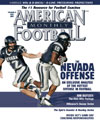AMERICAN FOOTBALL MONTHLY THE #1 RESOURCE FOR FOOTBALL COACHES
Article CategoriesAFM Magazine
|
The Pistol Offense - Part Iby: Mike Kuchar© More from this issue Without uncertainty, two of the most popular schemes in high school and college football today are the inside/outside zone play and the play action that results from it. Imagine the offensive productivity you’d have by being able to combine those two concepts while adding an element of misdirection? It’s exactly this kind of productivity that Chris Ault, head coach at Nevada, is having with the Wolf Pack since converting from an “I” formation to his own invention, the Pistol offense. After the 2004 season, Ault decided he needed to establish more of a run game to compete in the pass-happy Western Athletic Conference. But instead of installing the traditional zone and gap schemes most teams were running, he wanted to come up with something a little more innovative. So along came the Pistol, a spread shotgun hybrid, and wi....The full article can only be seen by subscribers. Subscribe today!
|
|
|||||||
| HOME |
MAGAZINE |
SUBSCRIBE | ONLINE COLUMNISTS | COACHING VIDEOS |
Copyright 2025, AmericanFootballMonthly.com
All Rights Reserved





